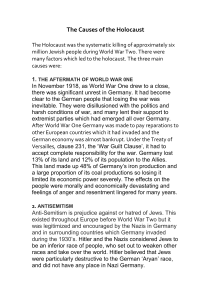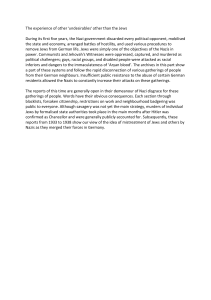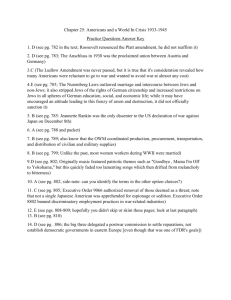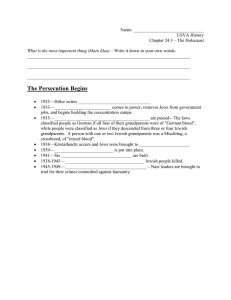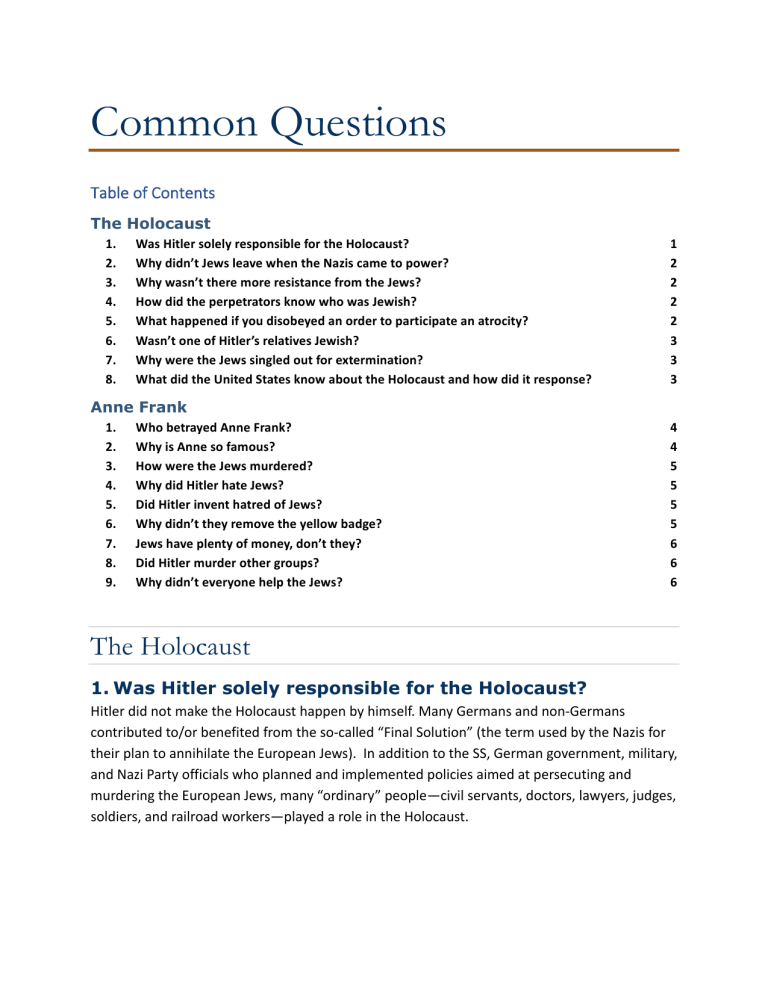
Common Questions Table of Contents The Holocaust 1. 2. 3. 4. 5. 6. 7. 8. Was Hitler solely responsible for the Holocaust? Why didn’t Jews leave when the Nazis came to power? Why wasn’t there more resistance from the Jews? How did the perpetrators know who was Jewish? What happened if you disobeyed an order to participate an atrocity? Wasn’t one of Hitler’s relatives Jewish? Why were the Jews singled out for extermination? What did the United States know about the Holocaust and how did it response? 1 2 2 2 2 3 3 3 Anne Frank 1. 2. 3. 4. 5. 6. 7. 8. 9. Who betrayed Anne Frank? Why is Anne so famous? How were the Jews murdered? Why did Hitler hate Jews? Did Hitler invent hatred of Jews? Why didn’t they remove the yellow badge? Jews have plenty of money, don’t they? Did Hitler murder other groups? Why didn’t everyone help the Jews? 4 4 5 5 5 5 6 6 6 The Holocaust 1. Was Hitler solely responsible for the Holocaust? Hitler did not make the Holocaust happen by himself. Many Germans and non-Germans contributed to/or benefited from the so-called “Final Solution” (the term used by the Nazis for their plan to annihilate the European Jews). In addition to the SS, German government, military, and Nazi Party officials who planned and implemented policies aimed at persecuting and murdering the European Jews, many “ordinary” people—civil servants, doctors, lawyers, judges, soldiers, and railroad workers—played a role in the Holocaust. Common Questions | Volunteer Materials 2. Why didn’t Jews leave when the Nazis came to power? Similar to their fellow citizens, German Jews were patriotic citizens. More than 10,000 died fighting for Germany in World War I, and countless others were wounded and received medals for their valor and service. The families of many Jews who held German citizenship, regardless of class or profession, had lived in Germany for centuries and were well assimilated by the early 20th century. From 1933–39, the German government passed and enforced discriminatory laws targeting Jews at a relatively gradual pace. Up until the nationwide anti-Jewish violence of 1938, known as Kristallnacht, many Jews in Germany expected to be able to hold out against Nazisponsored persecution, as they hoped for positive change in German politics. Before World War II, few could imagine or predict killing squads and killing centers. Those who made the difficult decision to leave Germany still had to find a country willing to admit them and their family. The search for safe haven was very difficult. The Evian Conference of 1938 showed this when almost every nation in attendance declined to change its immigration policies. Even when a new country could be found, a great deal of time, paperwork, support, and sometimes money was needed to get there. In many cases, these obstacles could not be overcome. 3. Why wasn’t there more resistance from the Jews? The statement that Jews did not fight back against the Germans and their allies is false. Jews carried out acts of resistance in every German-occupied country and in the territory of Germany’s Axis partners. Against impossible odds, they resisted in ghettos, concentration camps, and killing centers. There were many factors that made resistance difficult, however, including a lack of weapons and resources, deception, fear, and the overwhelming power of the Germans and their collaborators. 4. How did the perpetrators know who was Jewish? German officials identified Jews residing in Germany through census records, tax returns, synagogue membership lists, parish records (for converted Jews), routine but mandatory police registration forms, the questioning of relatives, and from information provided by neighbors and officials. In territory occupied by Nazi Germany or its Axis partners, Jews were identified largely through Jewish community membership lists, individual identity papers, captured census documents and police records, and local intelligence networks. 5. What happened if you disobeyed an order to participate an atrocity? Germans who refused to participate in atrocities were generally not punished, but risked peer, social, and sometimes professional exclusion or disadvantage. They could request other duties, such as guard duty or crowd control. There is no reliable evidence that German soldiers or Page 2 of 6 Common Questions | Volunteer Materials police officials were killed for refusing to kill civilians. Non-Germans serving as auxiliaries and refusing to carry out direct orders to kill could be subject to discipline, dismissal, imprisonment, or even death. 6. Wasn’t one of Hitler’s relatives Jewish? Rumors about Hitler’s ancestry were circulated by political opponents as a way of discrediting Hitler’s leadership of an antisemitic party. The rumors are derived largely —then and now— from the fact that the identity of Hitler’s paternal grandfather remains unknown. There is no reliable evidence, however, to suggest that the unknown grandfather was Jewish. 7. Why were the Jews singled out for extermination? The basis for Nazi antisemitism—prejudice against or hatred of Jewish people—was the Nazis’ distorted worldview of human history as racial struggle. The Nazis falsely considered the Jews to be a race. They incorrectly believed Jews had a natural impulse, inherited through generations, to strive for world domination, and that this goal would not only prevent German dominance but would also enslave and destroy the German “race.” The Nazis believed that all of history was a fight between races, which would culminate either in the triumph of the superior “Aryan” race or in its total extinction. As a result, Nazi leaders considered the death of all Jews to be a precondition necessary for the survival and the eventual dominance of the so-called “GermanAryan” race. According to the Nazis, the Jews, as an “inferior” race, would use their supposed control of world finances and of world mass media to support Communist uprisings and to encourage other “inferior” races to overwhelm and triumph against Nordic-Germanic races. Nazi antisemitism linked traditional negative and false images of Jews and their behavior with modern pseudo-scientific beliefs. Among these stereotypes were those derived from centuriesold Christian anti-Jewish thinking, which incorrectly presented Jews as murderers of Christ, agents of the devil, and practitioners of witchcraft. The Nazis linked these negative stereotypes to a “Jewish way of thinking” that they believed was based in genetics and, therefore, not subject to change. The Nazis used this belief to justify the discrimination, persecution, and, eventually, physical murder of Jewish people. 8. What did the United States know about the Holocaust and how did it response? Despite a history of providing sanctuary to persecuted peoples, the United States grappled with many issues during the 1930s that made living up to this legacy difficult. These issues included widespread antisemitism, xenophobia, isolationism, and a sustained economic depression. Unfortunately for those fleeing Nazi persecution, such issues greatly impacted US refugee policy, reinforcing an official and popular unwillingness to expand immigration quotas to admit www.holocaust.georgia.gov/volunteers Page 3 of 6 Common Questions | Volunteer Materials greater numbers of people endangered by Nazi persecution and aggression at a time when doing so might have saved lives. Over the years, scholarly investigation into US responses in the era of the Holocaust has raised a number of questions, such as: What did the United States know? What did government officials and civilians do with this knowledge? Could more have been done? Scholars have examined US immigration policy, the reactions of the US government to reported atrocities, and sluggish efforts to organize operations aimed at rescuing European Jews. Debates have sparked over key events, including the voyage of the St. Louis, the establishment of the War Refugee Board, the role of the American Jewish community, US media coverage of Nazi crimes and violence, and the contentious question of bombing Auschwitz. The topic continues to evolve with the introduction of new documentation and revised hypotheses. Source: http://www.ushmm.org/educators/teaching-about-theholocaust/common-questions Anne Frank 1. Who betrayed Anne Frank? Unfortunately, we can’t answer this one. There were suspicions about who the betrayer was and the first investigation took place in 1948. Fifteen years later there was another attempt to establish who betrayed the Franks. However, both investigations were inconclusive. The betrayer was not found. In December 2016, the Anne Frank House published an investigative study providing a new perspective on the impetus for the arrests at 263 Prinsengracht. It does not refute the possibility of betrayal but it addresses the existing assumption of betrayal and suggests new considerations. We should refrain from perpetuating the theory of betrayal as though it is proven fact. 2. Why is Anne so famous? First explain that Anne Frank was just an ordinary girl. There were many Jewish children just like Anne Frank. Like Anne many people kept a diary during the war. So that wasn’t unusual either. But most diaries weren’t published. After the war Anne’s father Otto Frank concentrated on having Anne’s diary published because he thought that his daughter’s message was important. Anne’s diary is also very well written for thirteen-year-old girl. Some even consider it literature. Many identify with her diary. It’s fascinating to read because it shows the war as it really was. Because we know what happened to Anne and her family it also makes the diary somewhat tragic. Page 4 of 6 Common Questions | Volunteer Materials The diary has been translated into more than 70 languages. There have been films made and plays written about Anne Frank. More than 1 million people visit the Anne Frank House every year. That’s why Anne is now so famous. 3. How were the Jews murdered? The answer to this is that they were killed in different ways. Some by being gassed, but many Jewish men, women and children, died as a result of disease and starvation. This is what happened to Anne Frank in Bergen-Belsen. Even before the extermination camps were built more than 500.000 Jews (especially in eastern European countries) were executed. 4. Why did Hitler hate Jews? An important term to mention here is ‘scapegoat’. Hitler and the Nazis said the Jews were responsible for huge events like losing World War One and the economic crisis. This was totally untrue. But by giving the Jews the blame Hitler created an enemy. Hitler said that all Germany’s problems had been caused by the Jews. Many people believed him. The solution to all these problems was to banish the Jews from society. With this political message and the promise to make Germany a large and economically powerful country Hitler’s party won the 1932 election. In 1933 he and his party came to power. 5. Did Hitler invent hatred of Jews? No, Hitler built on and used anti-Semitic ideas that already existed. He was Austrian and grew up in Vienna where the mayor was extremely anti-Semitic and where hatred of Jews was widespread. His hatred of Jews cannot be tied down to a specific event in his life, for example a Jewish childhood friend, as many children think. Hitler and the Nazis also thought that people could be divided into different races and that there was a struggle going on between these different races. According to the Nazis the ‘Aryan race’ was the best and strongest race. Jews were of another inferior race. In fact so inferior that they were not considered to be ‘people’ by the Nazis. 6. Why didn’t they remove the yellow badge? Explain that this was complex. Wearing the yellow badge was compulsory in The Netherlands from May 1942. Anne Frank also had to wear a star. For not wearing it you could be imprisoned for 6 months and also be fined 1 thousand guilders. Everybody realized that ‘imprisoned’ probably meant death in a German camp. So removing the yellow badge was severely punished. It was also very easy to check who was Jewish or not. Jews all had a ‘J’ stamped in their identity papers. Mention the term discrimination here. The Jewish star is an example of this. www.holocaust.georgia.gov/volunteers Page 5 of 6 Common Questions | Volunteer Materials 7. Jews have plenty of money, don’t they? This is a recurring comment and is a prejudice rooted in history. Hitler and the Nazis used propaganda to stir up hatred against the Jews. One of the prejudices Hitler tried to play out was that of ‘the rich, miserly Jew’. On posters, in films and speeches Jews were portrayed as stinking rich people hoarding their money; as opposed to other Germans who were poor and suffering because of the economic crisis. The propaganda was intended to evoke envy among Germans. They had come to believe that Jews were all rich and wanted to keep this all for themselves. But just as with other groups of people there were rich Jews but also Jews who were poor. Explain that the Nazis used propaganda in order to convince people. Explain what propaganda and prejudice is. 8. Did Hitler murder other groups? The Nazis ‘racial doctrine was based on different races. According to the Nazis the ‘Aryan race’ was the best, strongest and purest race. All others were inferior. Not only Jews were inferior according to the Nazis, but also homosexuals, Roma and Sinti and the handicapped. These were seen as a threat to the pure German race and because of this they were also persecuted. When explaining this it’s important to say that Hitler didn’t murder these people himself, but that many people agreed with his ideas and carried his ideas out. 9. Why didn’t everyone help the Jews? Not many people in The Netherlands helped the Jews. This doesn’t mean that those who didn’t helped the Nazis, but they didn’t do anything to stop them. Discuss people’s different motives for helping or not helping. You can illustrate this with Anne Frank’s story. Why did Miep Gies, Bep Voskuijl, Johannes Kleiman and Victor Kugler help? Because of: friendship, compassion and human obligation. It was dangerous to help Jews. Helpers risked imprisonment or deportation to a concentration camp. Fear prevented many from helping. Being discovered helping had enormous consequences. Source: http://www.annefrank.org/en/Education/Teachersportal/Pupilsquestions/ Page 6 of 6
